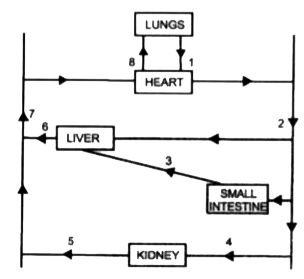The bulk of the heart wall is
endocardium
pericardium
epicardium
myocardium
The correct Answer is:D
To answer the question "The bulk of the heart wall is," we need to understand the structure of the heart wall, which consists of three main layers. Here’s a step-by-step breakdown of the solution:
Step 1: Identify the Layers of the Heart Wall
The heart wall is composed of three layers:
1. Endocardium - the innermost layer that lines the heart chambers.
2. Myocardium - the middle layer that consists of cardiac muscle tissue.
3. Epicardium - the outer layer, also known as the visceral pericardium.
Step 2: Determine the Function of Each Layer
- Endocardium: Provides a smooth lining for the heart chambers and is involved in the regulation of heart function.
- Myocardium: Responsible for the contraction of the heart, enabling it to pump blood throughout the body. This layer is significantly thicker than the other two layers.
- Epicardium: Serves as a protective layer and is involved in the production of pericardial fluid, which reduces friction between the heart and surrounding structures.
Step 3: Identify the Bulk of the Heart Wall
Among these three layers, the myocardium is the thickest and most substantial layer. It constitutes the bulk of the heart wall and is primarily responsible for the heart’s pumping action.
Step 4: Conclusion
Based on the information above, the correct answer to the question is:
D) Myocardium - This is the layer that forms the bulk of the heart wall.
The heart wall is composed of three layers:
1. Endocardium - the innermost layer that lines the heart chambers.
2. Myocardium - the middle layer that consists of cardiac muscle tissue.
3. Epicardium - the outer layer, also known as the visceral pericardium.
- Endocardium: Provides a smooth lining for the heart chambers and is involved in the regulation of heart function.
- Myocardium: Responsible for the contraction of the heart, enabling it to pump blood throughout the body. This layer is significantly thicker than the other two layers.
- Epicardium: Serves as a protective layer and is involved in the production of pericardial fluid, which reduces friction between the heart and surrounding structures.
Among these three layers, the myocardium is the thickest and most substantial layer. It constitutes the bulk of the heart wall and is primarily responsible for the heart’s pumping action.
Based on the information above, the correct answer to the question is:
D) Myocardium - This is the layer that forms the bulk of the heart wall.
Topper's Solved these Questions
- BIOTECHNOLOGY : PRINCIPLES AND PROCESSESBOOK - TRUEMEN BIOLOGY ENGLISHCHAPTER - BIOTECHNOLOGY : PRINCIPLES AND PROCESSESEXERCISE - MULTIPLE CHOICE QUESTIONS
124 Videos
- BREATHING AND EXCHANGE OF GASES BOOK - TRUEMEN BIOLOGY ENGLISHCHAPTER - BREATHING AND EXCHANGE OF GASES EXERCISE - MULTIPLE CHOICE QUESTIONS
199 Videos
Similar Questions
Knowledge Check
Which of the following chambers of the heart has the thickest muscular wall ?
ALeft atriumBRight atriumCRight ventricleDLeft ventricle
Muscles of heart are
View SolutionHeart wood is the
View SolutionHuman heart is
View SolutionThe wall of Human heart is thick due to presence of :−
View Solution[A]: in mammalian heart there is a very swift conduction of stimulation all over the walls of the heart
[R]: Conduction of stimulation is caused by Purkinje fibres and Bundle of His
View SolutionGive biological reason for the following:
The left ventricle of the heart has a thicker wall than the right ventricle.
View SolutionThe course of blood from the heart to the lungs and back to the heart is called
View Solution

